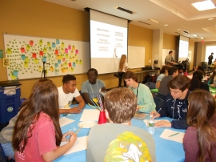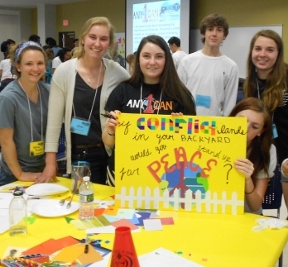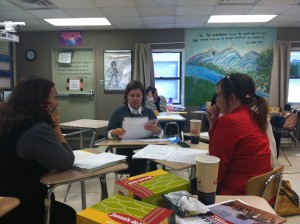Saturday, April 5, was a big day for us. In January, we officially took the plunge to plan and deliver the Any1Can You’re It! Global Youth Service Summit. It constituted a series of firsts . . . first time we hosted a youth service summit, first time we served as Youth Service America’s local lead agency, first time students from public and private high schools across the Charlotte-Mecklenburg School District came together in conjunction with Global Youth Service Day (April 11). We knew it would be a day of surprises – as are all “events.” But we really underestimated how much we would learn in the presence of approximately 125 students who are service leaders at 16 different schools. Given that the event came on the heels of “Top Ten Reasons” originator David Letterman announcing he will retire, we’re offering our “Top Ten List of Reasons our Eyes were Opened, Heads were Left Buzzing, and Spines are Still Tingling.” In reverse order, of course:
10. STUDENTS WILL GO OUT OF THEIR WAY ON A SATURDAY.
When we first decided to move ahead with the event, with limited time to  organize sponsors, partners, and commitments to attend, we held our breath. Will students come to a summit on a Saturday? We learned that we underestimated how moved and motivated they would be by the opportunity to come together to learn about and share experiences with service projects.
organize sponsors, partners, and commitments to attend, we held our breath. Will students come to a summit on a Saturday? We learned that we underestimated how moved and motivated they would be by the opportunity to come together to learn about and share experiences with service projects.
9. MUSIC MATTERS.
One of our facilitating partners, Leading2Change, insisted that we couldn’t have a youth summit without the right music. They were right. It was one of those intangibles that said “This summit is for you.”
8. SPECIAL VISITORS TAKE PEOPLE’S BREATH AWAY.
Our keynote speaker was 18-year-old Charles Orgbon, founder of Atlanta-based Greening Forward. He started his non-profit environmental efforts in the 6th grade. He’s now a high school senior. In six years his organization has supported projects engaging 2,000 students and 10,000 adults in environmental service.
7. LOCALS INSPIRE TOO. 
Students and an adviser from Charlotte Latin attended. We learned that this year they’ve raised $35,000 to support a school project in Tanzania, and they’re still going! Two students were the catalysts who proposed the project.
6. See #8 and note…
WE UNDERESTIMATE YOUTH, AND THEY UNDERESTIMATE EACH OTHER.
A common refrain was, “I had no idea other schools are working on stuff like we are at our school. I thought we were the only ones who cared about global issues and service.”
5. BETTER FUEL UP.
If you want a successful event, surprise students with fresh, hot pizza and snacks they like. Thanks, Fuel Pizza. Thanks, LANCE for the chips. Thanks, EarthFare for the apples, bananas and yummy juice. A collective gasp arose and hands clapped when we shared that lunch included you.
4. MISSING SKILL – ADVOCACY.
Asked for examples of their activities in the realms of Awareness, Service, Philanthropy or Advocacy, there were plenty of examples of the first three – almost no examples of the last (Advocacy). Facilitators asked “Why?” Participants responded: “Who wants to hear from
us?” and “We don’t know how to advocate.”
3. IF YOU WANT HONESTY, EXPECT UNCOMFORTABLE MOMENTS.
Like…the student troupe that performed at lunch and named specific issues at specific schools. Like…the dialogue in the economy workshop led a participant to share that his father lives and works in New York, while the family lives in Charlotte, because that’s where his father found the best job to put food on the table. They SKYPE each night, but miss each other a lot.
2. PEACE WINS.
Given seven different themes as options for creating a service campaign (education, poverty, hunger, water, peace, tolerance, and environment), peace and its parallel tolerance win out. But the truth is, we as facilitators don’t know why. We simply noticed a pattern.
1. FIRSTS ALWAYS LEAD TO THE QUESTION – WHAT NEXT?
Some students exchanged contact information on the spot and declared, “Look at me – I’m networking.” Twitter, Facebook and Instagram received their fair share of traffic. And the
general sentiment from students and facilitators indicated, this was a great first step.
And so . . . ?!



